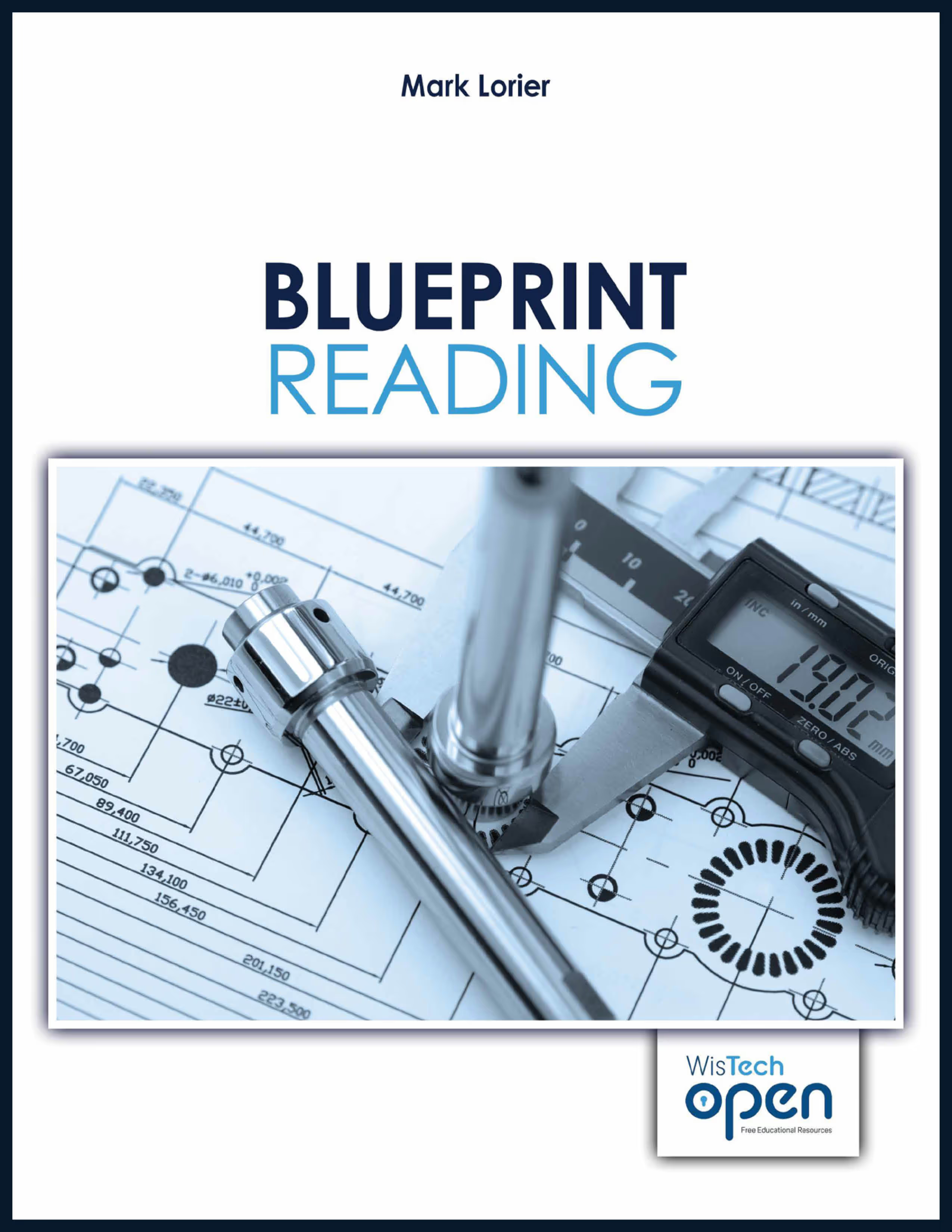Published
Estimated Publish Date
June 2025
Learn to interpret technical drawings with symbols, dimensions, and hands-on exercises for careers in trades and engineering.
.svg)
.svg)
Print Textbook: December 2025
Audiobook: TBD
Next Edition: 2030
1,085 students | 242 high school students | $219,791 student savings
Course Competency 1: Differentiate between drawings and prints.
- Explain the difference between drawings and prints.
- Describe engineering drawings.
- Demonstrate how to handle prints correctly.
Course Competency 2: Define terminology and abbreviations associated with print reading.
- Define print reading terminology.
- Explain machining terminology.
- Interpret abbreviations.
Course Competency 3: Interpret the layout of views of an object.
- Identify the primary views of an object.
- Select the placement of views on a print.
- Differentiate between pictorial and orthographic projection drawings.
- Demonstrate the use of projection lines.
- Determine appropriate dimensions of length, width, and height related to views.
- Differentiate between first and third angle projection on prints.
- Visualize basic shapes of objects.
Course Competency 4: Interpret the types of lines found on prints.
- Identify the types of lines found on prints.
- Describe the use of lines found on prints.
- Locate corresponding lines or surfaces in various views.
- Relate line types to part feature sizes.
Course Competency 5: Sketch objects in different views.
- Visualize how actual part features should appear based on print features.
- Sketch drawings, incorporating the alphabet of lines.
- Sketch simple orthographic drawings.
- Draw missing views of objects based on given views.
Course Competency 6: Differentiate dimensioning systems.
- Describe methods of dimensioning drawings.
- Relate dimensioning systems to mathematical concepts.
- Explain how baselines will be used for locating a part for manufacture.
- Explain how coordinate dimensioning is used in CNC machining.
- Convert dimensions to other units.
- Demonstrate the rules of dimensioning a part.
- Calculate the dimensions on a print.
Course Competency 7: Interpret dimensions on prints.
- Determine overall part sizes for stock selection.
- Apply mathematical concepts to interpret print dimensions.
- Determine part feature locations.
- Interpret angular measurements on prints.
- Calculate missing dimensions.
- Interpret part feature sizes.
- Identify critical dimensions.
Course Competency 8: Interpret title blocks.
- Describe the information found in a title block.
- Identify other elements of information found on a print.
- Identify the current drawing revision and the changes that have occurred to the part drawing.
- Apply tolerance information found in title blocks.
- Differentiate between specified and unspecified tolerances.
- Define tolerance terminology.
Course Competency 9: Calculate tolerances on dimensions.
- Define tolerance terminology.
- Apply mathematical concepts to determine tolerances on dimensions.
- Determine tolerances on dimensions.
- Determine limits on dimensions.
- Describe how tolerances affect mating parts.
Course Competency 10: Explain symbols and notes found on
prints.
- Identify symbols found on prints.
- Interpret machining symbols found on prints.
- Interpret surface texture symbols found on prints.
- Interpret common geometric symbols found on prints.
- Interpret notes commonly found on prints.
Course Competency 11: Analyze machining details.
- Define machining terminology.
- Identify machining detail.
- Determine the location of machined details.
- Determine the sizes of machined details.
- Explain the machining processes used to achieve the detail in the part.
- Specify the size of a contour.
- Calculate distances between machined details.
- Discuss order of operations related to machined details.
- Determine order of operations based on print specifications.
Course Competency 12: Interpret section views.
- Define section terminology.
- Identify various section lines.
- Interpret different types of sectional views.
Course Competency 13: Interpret working or detail drawings.
- Identify one-view drawings.
- Interpret details on one-view drawings.
- Identify multiple view drawings.
- Interpret details on multiple view drawings.
Course Competency 14: Interpret auxiliary views.
- Identify auxiliary views.
- Interpret details on auxiliary views.
- Determine dimensions on auxiliary views.
Course Competency 15: Interpret industrial prints.
- Identify assembly drawings.
- Identify parts lists.
- Interpret parts lists.
- Interpret sub-assembly drawings.
- Interpret detail drawings.
- Interpret working assembly drawings.
Course Competency 16: Layout dimensions and detail locations based on print specifications.
- Select material for layout.
- Apply layout die per procedural guidelines.
- Select baselines for layout (select appropriate surfaces).
- Calculate dimensions.
- Scribe lines for appropriate dimensions and detail.
- Compare layout to print specifications.
Course Competency 17: Develop a production process plan from a print.
- Determine processes needed to make part.
- Select tools.
- Calculate speeds and feeds.
- Discuss fixturing and work holding methods.
- Determine critical dimensions for inspection.
- Complete a process plan table.
You are free to:
– Share — copy and redistribute the material in any medium or format
– Adapt — remix, transform, and build upon the material for any purpose, even commercially
Under the following terms:
– Attribution — You must give appropriate credit to WisTech Open, provide a link to the license, and indicate if changes were made. You may do so in any reasonable manner, but not in any way that suggests WisTech Open endorses you or your use.
License: https://creativecommons.org/licenses/by/4.0/
WisTech Open, including the Open RN and Bright Beginnings series, does not provide ancillary or instructor materials. You can instead create free, customized resources—slides, quizzes, worksheets, study guides, and more—through our AI platform, WisTech Fusion: https://www.wistechopen.org/wistech-fusion
To help keep print textbook costs low for our students, please consider using an electronic version or purchasing a personal print copy rather than using the publisher/desktop version.

